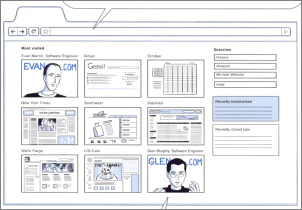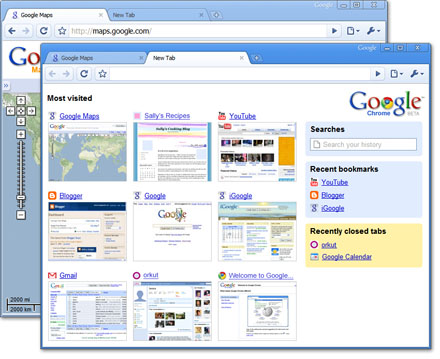Google Chrome, Google’s Browser Project
今天早上起来,在浏览新闻时,突然看到,google要推出浏览器.赶紧把这个小心告诉大家,期待ing.....................
好像有几个特点:
1:open source
2:优化了javascript的性能.
3,特别的 tab,不像FF一样,tab放在了最上方.
......E文不是很好,自己看吧
Google Chrome, Google’s Browser Project

Today there was a comic book in my mail, sent by Google and drawn by no less than Scott McCloud, creator of the classic Understanding Comics. Within the 38 pages, which I’ve scanned and put up, in very readable format Google gives the technical details into a project of theirs: an open source browser called Google Chrome. The book points to www.google.com/chrome, but I can’t see anything live there yet. In a nut-shell, here’s what the comic announces Google Chrome to be:
- Google Chrome is Google’s open source browser project. As rumored before under the name of “Google Browser”, this will be based on the existing rendering engine Webkit. Furthermore, it will include Google’s Gears project.
- The browser will include a JavaScript Virtual Machine called V8, built from scratch by a team in Denmark, and open-sourced as well so other browsers could include it. One aim of V8 was to speed up JavaScript performance in the browser, as it’s such an important component on the web today. Google also say they’re using a “multi-process design” which they say means “a bit more memory up front” but over time also “less memory bloat.” When web pages or plug-ins do use a lot of memory, you can spot them in Chrome’s task manager, “placing blame where blame belongs.”
- Google Chrome will use special tabs. Instead of traditional tabs like those seen in Firefox, Chrome puts the tab buttons on the upper side of the window, not below the address bar.

- The browser has an address bar with auto-completion features. Called ’omnibox’, Google says it offers search suggestions, top pages you’ve visited, pages you didn’t visit but which are popular amd more. The omnibox (“omni” is a prefix meaning “all”, as in “omniscient” – “all-knowing”) also lets you enter e.g. “digital camera” if the title of the page you visited was “Canon Digital Camera”. Additionally, the omnibox lets you search a website of which it captured the search box; you need to type the site’s name into the address bar, like “amazon”, and then hit the tab key and enter your search keywords.
- As a default homepage Chrome presents you with a kind of “speed dial” feature, similar to the one of Opera. On that page you will see your most visited webpages as 9 screenshot thumbnails. To the side, you will also see a couple of your recent searches and your recently bookmarked pages, as well as recently closed tabs.

- Chrome has a privacy mode; Google says you can create an “incognito” window “and nothing that occurs in that window is ever logged on your computer.” The latest version of Internet Explorer calls this InPrivate. Google’s use-case for when you might want to use the “incognito” feature is e.g. to keep a surprise gift a secret. As far as Microsoft’s InPrivate mode is concerned, people also speculated it was a “porn mode.”
- Web apps can be launched in their own browser window without address bar and toolbar. Mozilla has a project called Prism that aims to do similar (though doing so may train users into accepting non-URL windows as safe or into ignoring the URL, which could increase the effectiveness of phishing attacks).
- To fight malware and phishing attempts, Chrome is constantly downloading lists of harmful sites. Google also promises that whatever runs in a tab is sandboxed so that it won’t affect your machine and can be safely closed. Plugins the user installed may escape this security model, Google admits.
This looks like a very interesting project, and I think it can’t hurt to have more competition in the browser area. Google is playing this as nicely as possible by open-sourcing things, with perhaps part of the reason to try to defend against monopoly accusations – after all, Google already owns a lot of what’s happening inside the browser, and some may feel owning a browser too could be a little too much power for a single company (Google could, for instance, release browser features that benefit their sites more than most other sites... as can Microsoft with Internet Explorer). For now, until Chrome is released in a testable version, how much of the speed, stability and user interface promises will be fullfilled – and how much of the interface you’ll be able to configure in case you don’t like it – remains to be seen.
[Images by Google.]
Update: Google now posted on this at their blog, announcing the launch date to be tomorrow, Tuesday.
Update 2: At gears.google.com/chrome/, screenshots of Google Chrome have appeared:

The service’s logo is also shown on that page (it also appears in Google’s official reprint of the comic at Google Books):




